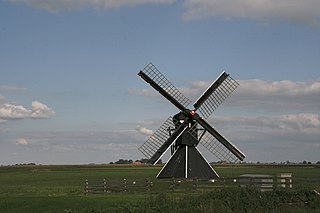
De Heimerter Mole is a hollow post mill in Burgwerd, Friesland, Netherlands which has been restored to working order. The mill is listed as a Rijksmonument, number 39348.

De Princehofmolen is a hollow post mill in Earnewâld, Friesland, the Netherlands, which was built in 1958. The mill is listed as a Rijksmonument, number 22934.

Arkens is a Hollow Post mill in Franeker, Friesland, Netherlands which has been restored to working order. The mill is listed as a Rijksmonument, number 15710. It shares its name with the eponymous hamlet, just north of Franeker, Arkens.

De Modderige Bol is a Hollow Post mill in Goëngahuizen, Friesland, Netherlands which has been restored to working order. The mill is listed as a Rijksmonument, number 34001.

Heechhiem is a Hollow Post mill in Goëngahuizen, Friesland, Netherlands which has been restored to working order. The mill is listed as a Rijksmonument, number 33999.

Molen Hoogland is a Hollow Post mill in Goutum, Friesland, Netherlands which was built in 2004. The mill is listed as a Rijksmonument, number 24521.
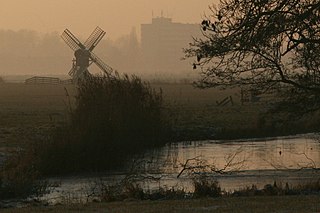
De Oegekloostermolen is a hollow post mill in Hartwerd, Friesland, Netherlands which was built before 1830. The mill has been restored to working order. It is listed as a Rijksmonument, number 39347.

De Groene Molen is a hollow post mill in Joure, Friesland, Netherlands which was built c. 1800. The mill has been restored so that it can turn by wind. It is listed as a Rijksmonument, number 18208.

De Bullemolen English: The Executioner's Mill is a smock mill in Lekkum, Friesland, Netherlands which was built in 1825. The mill has been restored to working order and is listed as a Rijksmonument, number 24505.

Terpzigt is a drainage mill in Marssum, Friesland, Netherlands. It is the smallest spinnenkop, a type of hollow post windmill. The mill is listed as a Rijksmonument, number 8625.

The Monnikenburenmolen or Nijhuizumermolen is a drainage mill in Nijhuizum, Friesland, Netherlands. It was restored in 2008 after it was only just saved from demolishment in 1994. It is a hollow post windmill of a type called "spinnenkop" by the Dutch. The mill is listed as a Rijksmonument, number 527646. It can help drain the polder and has been designated as a backup to the pumping station by the waterboard Wetterskip Fryslân.

The Geeuwpoldermolen is a drainage mill near the twin village of Oppenhuizen, Friesland, Netherlands. It is a hollow post windmill of the type called spinnenkop by the Dutch. The mill is listed as a Rijksmonument, number 39810 and it is still in use for draining the Geeuwpolder. It was almost completely renewed at a restoration in 1987, earlier restorations were in 1954 and 1965.
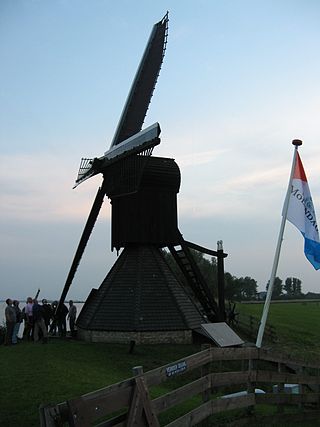
Doris Mooltsje is a drainage mill near the village of Oudega, Friesland, Netherlands. It is a hollow post windmill of the type called spinnenkop by the Dutch. The mill is listed as a Rijksmonument, number 527647 and has been restored to working order in 1998.
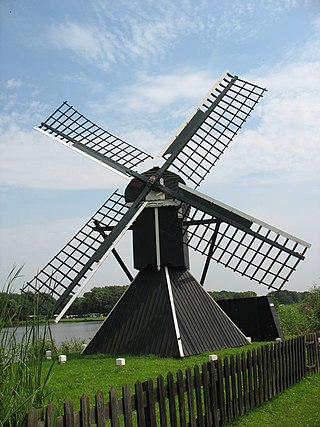
The Himriksmole, also known as Groene Ster after the recreational area and nature reserve where it is located, is a drainage mill near the village of Tytsjerk, Friesland, Netherlands. It is a hollow post windmill of the type called spinnenkop by the Dutch. The mill is listed as a Rijksmonument, number 35675, and is used to raise the water level in the nature reserve.

Teetlum, after a nearby terp, also known as Duivenhok 'dove coat' named after the polder it drained, is a drainage mill near the village of Tzum, Friesland, Netherlands. It is a hollow post windmill of the type called spinnenkop by the Dutch. The mill is listed as a Rijksmonument, number 15877 and can be used to drain the adjacent polder.
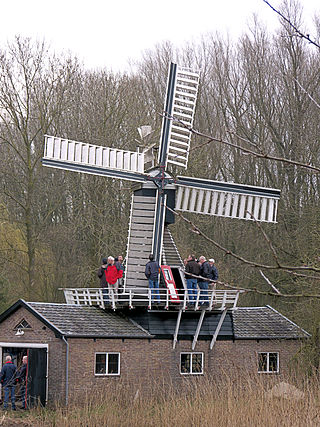
Spinnenkop Wedderveer is a wind powered sawmill in the village of Wedderveer, Groningen, Netherlands. It is a hollow post windmill of the type called "spinnenkop" by the Dutch built on top of a brick shed. The mill is listed as a Rijksmonument, number 388083 and is in working order.
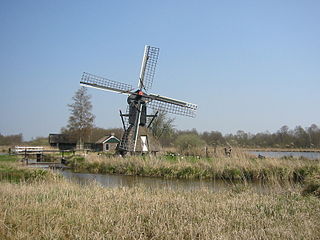
De Wicher is a drainage mill near the village of Kalenberg, Overijssel, Netherlands. It is a hollow post windmill of the type called spinnenkop by the Dutch. The mill is in working order and used to drain the reed beds during winter to improve accessibility for reed cutters.

The spinnenkop of the Netherlands Open Air Museum in Arnhem is a small drainage mill originally located near Gorredijk, Friesland, Netherlands. It is a hollow post windmill that has been restored to working order.

De Skarrenmolen is a smock mill in Scharsterbrug, Friesland, Netherlands which was built in 1888. The mill has been restored to working order. It is listed as a Rijksmonument.

De Vrouwbuurstermolen is a smock mill in Vrouwenparochie, Friesland, Netherlands which was built in 1862 and is in working order. The mill is listed as a Rijksmonument.





















